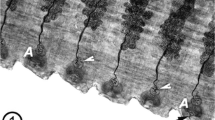Summary
The paired testes of the spider miteTetranychus urticae are divided in a part producing germ cells and a secretory portion with a vast lumen. The secretory part is tubular and is connected to a vesicula seminalis that begins with paired pieces and then becomes unpaired. The penis is composed of two different parts: an evagination of the body wall that is penetrated by the ejaculatory duct and a ventral cuticular invagination the proximal part of which is an insertion for protractor muscles.
The ultrastructures of the male genital tract and of the receptaculum seminis of the female are described in detail.
The germinal epithelium is built up of a multinuclear somatic cell which envelops the germ cells. The spermiogenesis is characterized by the following features: invagination of the plasma membrane, degeneration of cell organelles, reduction in size and condensation of nucleus and cytoplasm. The germ cells lack flagellum and aerosome. The sperms leave the germ producing part of the testis with roundish shape, the invaginations — now pinched off the cell membrane — are to be seen as peripherally located vesicles. The chromatin is condensed, a nuclear envelope is absent. Mitochondria, a Golgi apparatus and ribosomes are reduced.
In the receptaculum seminis the sperms are of irregular shape, they bear finger-shaped processes. Below the cell membrane numerous tubules are to be found.
Zusammenfassung
Die paarigen Hoden vonTetranychus urticae sind wie die anderer prostigmater Milben in einen Keimteil und einen Drüsenteil, der ein weites Lumen (Hodenlumen) enthält, gegliedert. Der Drüsenteil ist schlauchförmig und geht in eine anfangs paarige, dann unpaarige Vesicula seminalis über. DerTetranychus- Penis besteht aus zwei verschiedenen Teilen: einer Ausstülpung der Körperwand, die vom Ductus ejaculatorius durchzogen wird, und einer ventral davon gelegenen kutikularen Einstülpung, an deren proximalem Ende Penisprotraktoren ansetzen.
Eine Beschreibung der Feinstruktur der einzelnen Elemente des männlichen Genitaltraktes sowie des Receptaculum seminis des Weibchens wird gegeben.
Der Keimteil des Hodens wird aufgebaut von einer vielkernigen somatischen Zelle, die die Keimzellen umgibt. Die Spermiocytogenese ist durch folgende Vorgänge gekennzeichnet: Einfaltung der Zellmembran, Degeneration von Zellorganellen, Größenabnahme und Kondensation von Kern und Cytoplasma. Kinocilie und Akrosomkomplex werden nicht ausgebildet. Die Spermien verlassen den Keimteil als kugelige Gebilde, die abgeschnürten Einstülpungen liegen als periphere Vesikel unter der Zellmembran. Das Chromatin ist kugelförmig zusammengeballt, eine Kernhülle ist nicht vorhanden. Mitochondrien, Golgi-Apparat und Ribosomen sind verschwunden.
Im Receptaculum seminis bekommen die Spermien eine unregelmäßige Gestalt mit fingerförmigen Ausläufern. Unter der Zellmembran und parallel zu ihr liegen zahlreiche Tubuli.
Similar content being viewed by others
Literatur
Alberti, G.: Fortpflanzungsverhalten und Fortpflanzungsorgane der Schnabelmilben (Acarina: BdeUidae, Trombidiformes). Z. Morph. Tiere78, 111–157 (1974)
Alberti, G., Storch, V.: Spermiocytogenese, Spermien und Sperma ophpre von Schnabelmilben (Bdellidae, Acari). Acta Zoologica (im Druck, 1976)
Blauveit, W.E.: The internal anatomy of the common red spider mite (Tetranychus telarius Linn.). Cornell Univ. Agric. Expt. Sta. Nem.270, 3–46 (1945)
Breucker, H., Horstmann, E.: Die Spermatozoen der ZeckeOrnithodorus moubata (Murr.). Z. Zellforsch.88, 1–22 (1968)
Breucker, H., Horstmann, E.: Die Spermatogenese der ZeckeOrnithodorus moubata (Murr.). Z. Zellforsch.123, 18–46 (1972)
Brinton, L.P., Burgdorf, W., Oliver, J.H. jr.: Histology and finestructure of spermatozoa and egg passage in the female tract ofDermacentor andersonii Stiles (Acari — Ixodidae). Tissue & Cell6, 109–125 (1974)
Ehara, S.: Comparative studies on the internal anatomy of three Japanese Trombidiforme Acarinids. J. Fac. Sci. Hokkaido Univ. ser. VI, Zoology14, 410–434 (1960)
Franzeh, Å.: Phylogenetic aspects of the morphology of spermatozoa and spermiogenesis. In: Comparative spermatology (B. Baccetti, ed.), pp. 29–46. New York-London: Academic Press 1970
Gasser, R.: Zur Kenntnis der gemeinen SpinnmilbeTetranychus urticae Koch. 1. Mitteilung: Morphologie, Anatomie, Biologie und okologie. Mitt. Schweizer. Entom. Ges.24, 217–262 (1951)
Mathur, S.N., Le Roux, E.J.: The reproductive organs of the velvet miteAllothrombium lerouxi (Trombidiformes: Trombidiidae). Can. Ent.102, 144–157 (1970)
Moss, W.W.: Description and mating behaviour ofAllothrombium lerouxi, new species (Acarina: Trombidiidae) a predator of small arthropods in Quebec apple orchards. Can. Ent.92, 898–905 (1970)
Nalepa, A.: Die Anatomie der Phytopten. S.-B. Akad. Wiss. Wien math.-nat.96, 115–165 (1887)
Oldfield, G.N., Hobza, R.F., Wilson, N.S.: Discovery and characterization of spermatophores in the Eriophyoidea (Acari). Ann. ent. Soc. Am.63, 520–526 (1970)
Oliver, J.H. jr., Brinton, L.P.: Cytogenetics of ticks (Acari: Ixodoidea). 7. Spermatogenesis in the Pacific coast tick,Dermacentor occidentalis Marx (Ixodidae). J. Parasit.58, 365–379 (1972)
Reger, J.F.: The fine structure of spermatids from the tick,Amblyomma dissimili. J. Ultrastruct. Res.5, 584–599 (1961)
Reger, J.F.: A fine structure study on spermiogenesis in thetick, Amblyomma dissimili, with special reference to the development of motile processes. J. Ultrastruct. Res.7, 550–565 (1962)
Reger, J.F.: Spermiogenesis in thelick, Amblyomma dissimili, as revealed by electron microscopy. J. Ultrastruct. Res.8, 607–621 (1963)
Reger, J.F.: An unusual membrane organization observed during spermiogenesis in the miteCaloglyphus anomalus. J. Ultrastruct. Res.36, 732–742 (1971)
Rosati, F., Baccetti, B., Dallai, R.: The spermatozoa of Arthropoda.X. Araneids and the lowest Myriapods. In: Comparative Spermatology (B. Baccetti, ed.), pp. 247–254. New York-London: Academic Press 1970
Vitzthum, H., Graf von: Acarina. In: Bronns Klassen und Ordnungen des Tierreichs. 5. Abt. 4. Buch 5, 1011 S. Leipzig: Akadem. Verlagsges. 1943
Witalinski, W.: Spermatogenesis in a free living mite,Pergamasus viator Halaŝ (Parasitidae, Mesostigmata). I. Fine structure of spermatozoa. Z. mikr.-anat. Forsch.89, 1–17 (1975)
Witte, H.: Funktionsanatomie der Genitalorgane und Fortpflanzungsverhalten bei den Männchen der Erythraeidae (Acari, Trombidif ormes). Z. Morph. Tiere80, 137–180 (1975)
Witte, H., Storch, V.: Licht- und elektronenmikroskopische Untersuchungen an Hodensekreten und Spermien der trombidiformen MilbeAbrolophus rubipes (Trouessart, 1888) Acarologia15, 441–450 (1973)
Zacher, F.: Arachnoidea. In: Handbuch der Pflanzenkrankheiten. 4. Tierische Schädlinge an Nutzpflanzen, 1. Teil, 5. Aufl., S. 139–207. Berlin-Hamburg: Parey 1949
Author information
Authors and Affiliations
Rights and permissions
About this article
Cite this article
Alberti, G., Storch, V. Ultrastruktur-Untersuchungen am männlichen Genitaltrakt und an Spermien vonTetranychus urticae (Tetranychidae, Acari). Zoomorphologie 83, 283–296 (1976). https://doi.org/10.1007/BF00993514
Received:
Issue Date:
DOI: https://doi.org/10.1007/BF00993514



